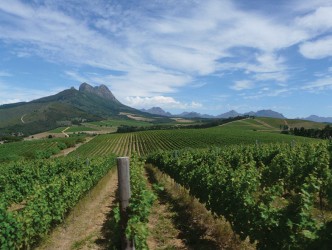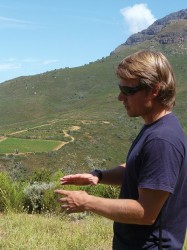Amanda LeNeve

Photo: Mauve Pagé (pageanddesign.com)
We arrived in Cape Town within hours of Nelson Mandela’s death. My friend Mauve and I looked at each other in shock as we heard the news over the radio on the airport shuttle to our hotel.
We knew our time in South Africa was going to be special for many reasons, but visiting the country at this particular time was truly serendipitous.
As we spent the next four days immersing ourselves in South Africa’s Stellenbosch wine region, whether explicitly explained or subtly referenced, it’s clear that Mandela and the revolution he inspired was also integral in shaping South Africa’s wine identity.
Though considered a new world wine region, wine has been made in South Africa since 1659 — February 2, to be exact. In his book, Wines of the New South Africa (University of California Press, 2013), Tim James references Dutch East India Company’s Jan van Riebeeck’s logbook entry on this day.
“Today, God be praised, wine was pressed for the first time from Cape grapes… mostly Muscatel and other white, round grapes, very fragrant and tasty. These grapes, from three young vines planted two years ago, have yielded about 12 quarts of must, and we shall soon discover how it will be affected by maturing.”
Fast forward to the 1970s, South Africa’s wine industry had grown significantly and was now primarily controlled by the Cooperative Winegrowers Association of South Africa Limited (more commonly known as the KWV). Unfortunately, though the organization was started with good intentions, bureaucracy and power got the best of it, contributing to a breakdown in the winemaking community and an overall reduction in quality.
Despite the tight controls the KWV placed on wine making, winemakers throughout South Africa were quietly coming together to learn, share and strive to make wine they were proud of.
A new identity
One of the players at this time was Edmonton-native Norma Ratcliffe, who was married to South African Stan Ratcliffe.
The Ratcliffes purchased a farm north of the town of Stellenbosch called Warwick in 1964 and began selling the grapes they grew to help pay their mortgage.
“In the early days, we even grew vegetables and brought them to market — we needed the money to help pay our mortgage,” Norma explained.
“When we paid off our mortgage in 1984, we produced our first wine. We made some money and we built a little winery and we continued to build it piece by piece as we had the money to do it.”
At the time, Norma was the first female winemaker in South Africa with her own estate.
For their first vintage in 1984, the Ratcliffes’ made a 100 per cent Cabernet Sauvignon, but they thought Bordeaux-style blends could work well for the Stellenbosch region.
“My husband and I had been to Bordeaux and we thought that would be the way to go here. So, in the late 70s we planted Cabernet Franc and Merlot. In ‘84 we bottled 100 per cent Cabernet [Sauvignon], which was a great hit. In ‘85 we did a Bordeaux blend and in ’88, we bottled our first Cabernet Franc as a varietal — we were kind of the leaders in that.”
A few other producers had the same idea and were also developing Bordeaux blends.
“It was just starting, but people were starting to use new French oak barrels to raise the quality. So, we started importing barrels in ‘84 — it made the difference, but then it was about learning how to handle wood and wine, which is a whole other thing.”
Though the Ratcliffes and many other South African winemakers at the time were pushing the boundaries, trying new things and producing high quality wines, Apartheid isolated South African product from the international wine market.
But on February 11, 1990, that all changed.
“When they let Mandela out of jail, it changed everything because then we were able to export. From that day, people were swarming, running around and looking for agencies.”
Warwick’s first exports were to Germany. Today, they still have the same importer to that country. Warwick now exports about 35 per cent of the wine they produce to 22 countries, including Canada.
Norma is now mostly retired from active participation at Warwick. Her son, Mike, runs the business, yet she continues to be an active and iconic member of the South African wine community.
The next generation

Photo: Mauve Pagé (pageanddesign.com)
More than 20 years removed from Apartheid times, the next generation of winemakers are doing their part in reinventing what it means to make wine in South Africa.
Alex Starey of Keermont Vineyards is one of them.
Keermont is nestled in hills of the Blaauwklippen Valley south of Stellenbosch. With vineyards planted on steep mountain slopes, it’s clear that Alex and farm owner Mark Wraith have a keen interest in expressing their unique location and its terroir in the wines they produce.
“It’s our aim to guide the grapes through the cellar and out the door without actually putting too much of a thumb print on it,” Alex explained as he drove the farm’s Land Rover up the vineyard’s steep and rocky roads past beautiful prehistoric-looking protea.
“We have fantastic vineyards, so the purer the wine, the older the barrel we use — that sort of thing — the better the wine actually tastes to me.”
Like many other young South African winemakers, Alex has been influenced by time spent working with winemakers in other parts of the world, including the northern Rhone’s Côte-Rôtie, Spain and Chile.
“It showed me that I don’t have to obey these rules that everyone’s been playing by. South Africans and the courses I took at the university teach a very conservative approach to winemaking. When you start working with Europeans, it blows your mind.
“Quite a few young producers in South Africa now are interested in breaking the norm and doing things a little bit out of the box.
“People are starting to think about what they can do differently — ferment in eggs, use foudre or age the wine under water. I like that. I think there’s a big revolution happening, in a way. And, the export industry is really looking for that.”
As Alex talked about his friends and the different things they’re doing to raise the level of wines produced here, I was reminded of my discussion with Norma Ratcliffe a few days earlier.
She spoke fondly of her early days making wine and her community of winemakers trying to challenge what it meant to make wine in this country. Alex and his friends are now doing the same and are driving each other to experiment and challenge convention. It’s an exciting time for South African wine.
Before visiting this beautiful country, I didn’t spend much time in the South Africa section at the wine store. But, Alex, Norma and the many others we spoke to on our visit have changed my mind.
I’m looking forward to a long life drinking South African wine.